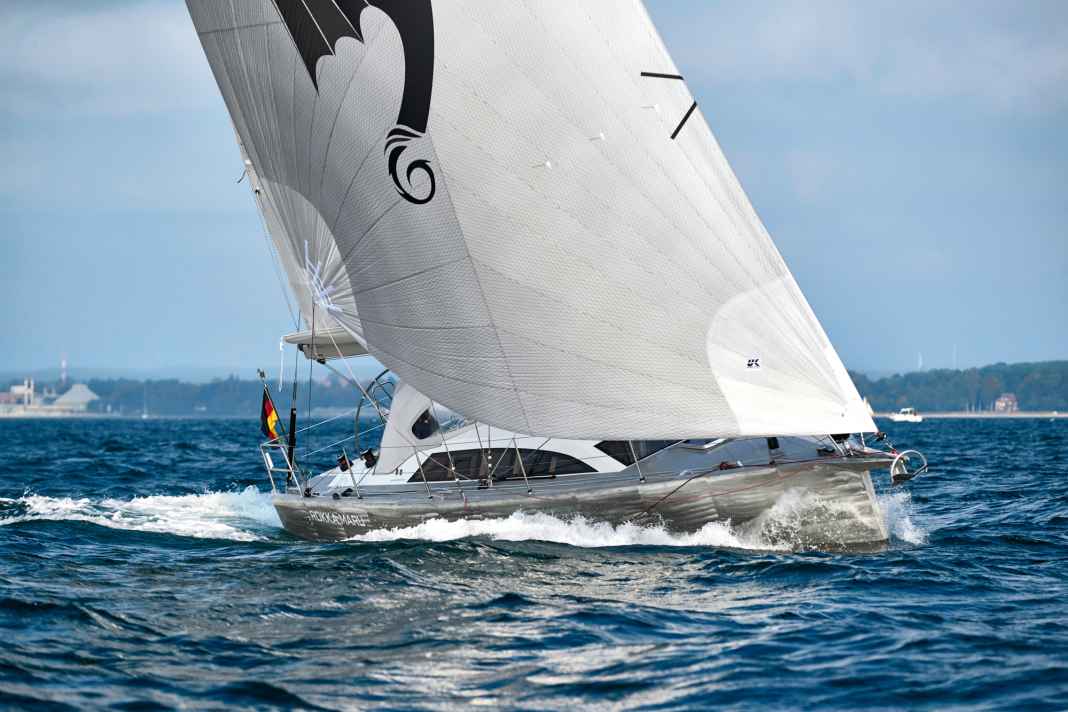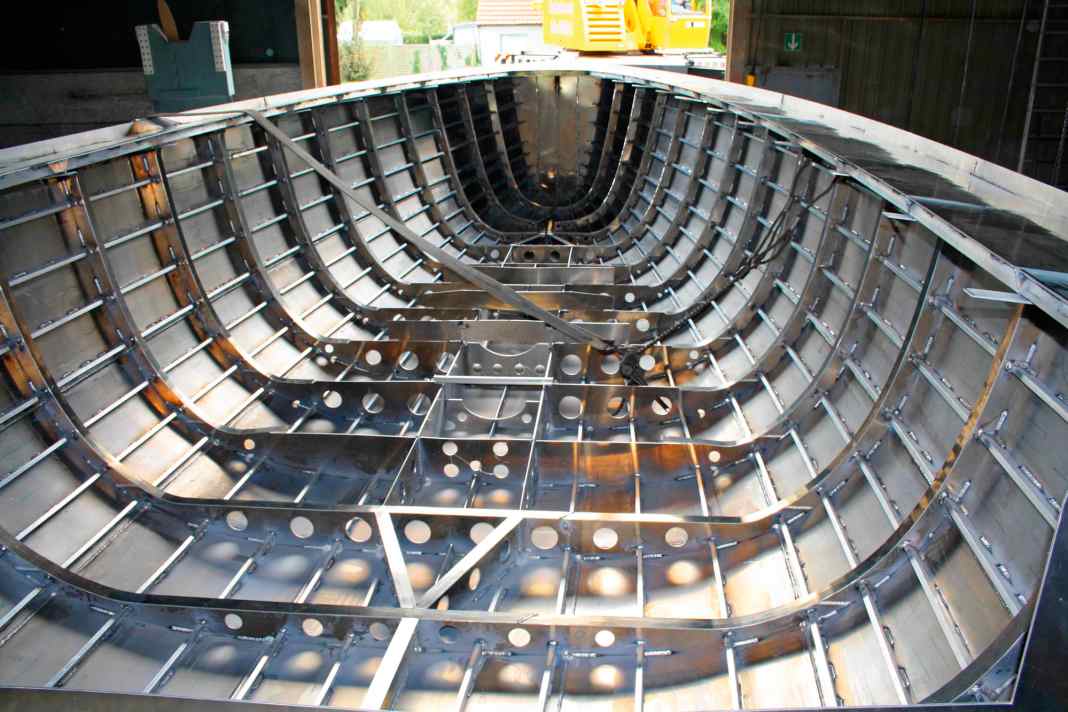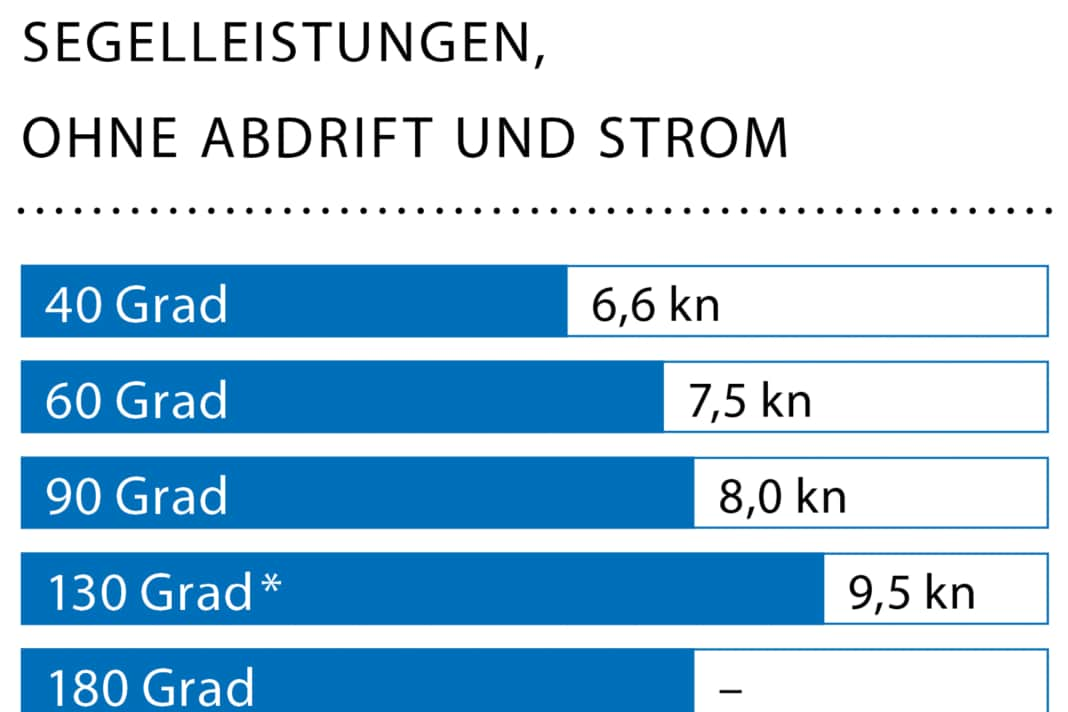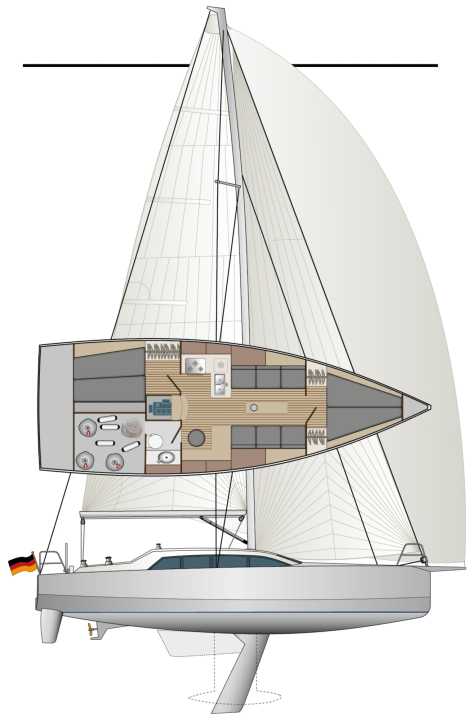





It doesn't always have to be GRP from mass production. Far from the mainstream, aluminium has established itself as an alternative material for yachts, if not further. The upmarket products from Allures, Ovni or Garcia from France are just as popular with blue water sailors as those from K & M, Koopmans or Hutting from Holland. The Polish catamaran manufacturer Sunreef has also gained market share with yachts made of light metal. What they all have in common is that they are pure touring yachts, mostly built for long journeys, but also popular for the high latitudes.
In this respect, the aluminium boats from Berckemeyer Yacht Design occupy a special position. Owner Martin Menzner from Stein near Kiel, himself an experienced and versatile sailor with a penchant for sport and holder of around 15 titles as German champion in the J/22 and J/80 classes, favours performance-oriented modern yachts.
This might also interest you:
He also has a conservative line in his programme with his "Bristol" series and shows another side of his skills with the highly acclaimed LA 28 mahogany cigar. But the main business with a wide variety of types is the rest of the BM range. It is characterised by modern lines with wide sterns, the fashion trend of the Chinese is accommodated by the construction with aluminium panels. The range is rounded off by plenty of fabric and effective attachments, which can also be swivelled or lifted as required.
The boats can be built at various shipyards and customised by different experts. A tried and tested combination is a completely German solution. This is hull construction by Benjamins in East Frisia, and fitting out by neighbour Siemer or Koch in Thuringia, as in the case of the BM 36 tested.
Lightweight aluminium
The ship is the designer's smallest aluminium yacht. "A boat of this size can still be reasonably made from five millimetre thick panels. A smaller one would be too heavy. And thinner panels dent during welding," says the expert.
However: The BM 36 does not appear to have a weight problem. With a displacement of 6.0 tonnes, the boat weighs no more than comparable GRP yachts. If you put sail area and weight in relation to each other (sail carrying capacity), the BM 36 has a (dimensionless) value of 4.7, which in theory makes it a sporty cruising boat.
It also looks the part. During the test in 2018, the welded bowsprit catches the eye at the jetty in Neustadt, which guides the neck of the gennaker or Code Zero, carries the anchor permanently and serves as a welcome step. The large width of a full 3.80 metres is just as striking as the actually high cabin superstructure, which appears more filigree than the rest of the typically coarser aluminium details such as the welded-on cleats; beautifully sprayed white, it also appears flatter than it actually is. In the meantime, the hull lines have been revised even further up to the year 2025. In the large cockpit, a wheel with a diameter of 1.60 metres is guided through a guiding trench. This makes it large enough to sit outside and flat enough to steer standing behind it.
Clever controls
The boat is equipped with double rudder blades, which has no effect when casting off astern and hardly any effect when manoeuvring. The fins are moved by an excellently functioning Jefa system based on push rods. The wheel works without play or slippage and quite directly; one turn is enough to move the fins from stop to stop.
Power is transmitted via a push rod to a gearbox, which is positioned vertically and therefore requires one less deflection compared to the conventional arrangement, which saves money and friction. The gearbox moves two push rods that are connected to the rudder cokers. The linear drive of the autopilot, also from Jefa, acts on the starboard rudder, which executes the steering impulses simultaneously with the port rudder via the system. All in all, a practical and excellent solution.
In order to sit perfectly on the outside as a helmsman and have an optimum view forwards, a larger wheel would be desirable, which can be realised in the same way as two smaller wheels or even a tiller steering. Aluminium enables individual construction with many solutions. The boat is also available with a swivelling keel.
Double headsail
The rig also has special features. The Seldén profile C 227 (227 by 119 millimetres), selected with high safety reserves, is equipped with a cutter stay that is permanently attached. It is positioned well below the mast and well behind the forestay on deck. The working jib or trinquette, as the French call it, among whom this geometry is very popular, is rolled up ready for use with its own set of sheets, tracks and deflectors. To keep the cutter stay under tension, the boat only needs spreaders angled at 23 degrees.
In addition, backstays made of Dyneema are hanging ready to be used to stabilise the mast, which, according to Martin Menzner, is a purely precautionary measure in view of the mast's considerable section modulus.
The test reveals the rig's special features and advantages. In 12 to 15 knots of wind and increasing waves, the BM 36 achieves a solid 6.5 knots of speed under genoa and full main on the wind, and this with a small tacking angle of 80 degrees. To tack, the genoa has to be pulled around the cutter stay - this takes a little time, but hardly any effort. And at this wind speed, the working jib can already be used, which is very easy to tack with the genoa furled.
For less wind, the BM 36 is fitted with a rolled Code Zero on the bowsprit, which, like the rest of the wardrobe, comes from UK Sailmakers in Flensburg and makes an excellent impression. The high-cut laminate sail, which is rather round at the top, can also be used well on deeper courses and is a good alternative to a gennaker thanks to its easy handling.
Regardless of which sail is to be used, the size and positioning of the winches, blocks, stoppers and rails makes sense.
Aisled interior
Below deck, the boat is sleek and modern according to the owner, who owns his first ocean-going yacht and plans to sail the Atlantic in the medium term - there is no trace of the rough exterior. The aluminium construction can only be found behind panelling or in the bilge.
The large superstructure windows, the panoramic window and the many white surfaces bring plenty of light into the ship. That's nice, but nothing special. What is striking is the navigation system built around the corner, which provides support in rough seas and whose large surface can also be used for work in the galley opposite. The voluminous locker is not only accessible from above, but also through the wet cell, which can be an advantage. The custom-fit floorboards are stabilised with spacers and are creak-free. Long handles on the saloon ceiling provide support, and the fold-up backrests of the saloon sofas create space and comfort, turning them into welcome sea berths with leeboards.
The cross ventilation and storage space in the saloon could be improved - points which, like any design, dimensioning or layout, can easily be cancelled or modified. Simply aluminium construction.
The BM 36 sails excellently, is easy to handle, is also great fun on the wheel, has a versatile rig and offers a successful finish. What's more, the boat is almost as customisable as a one-off. Don't worry, there is a downside: at around 340,000 euros, the basic price of the boat is around double that of a yacht from a large series. Adjusted for equipment - the BM 36 is very well equipped - the delta is still enormous. The small production run and the associated major disadvantages in purchasing, for example, are reflected in the price.
The price is high, but ultimately seems appropriate. After all, the owner not only gets a highly customisable boat, but also an inherently individual boat, indeed an ocean-going yacht of a special kind: the BM 36 is one of the few examples of aluminium performance cruisers.
Various models



A special feature of aluminium yachts is that the interior does not contribute to the load-bearing structure and the position of the bulkheads and fittings can be freely selected. This means that The boat and fittings do not have to come from a single source. The BM hulls, for example, are produced by the Benjamins yacht yard in East Frisia or another manufacturer, while the fittings come from companies such as the neighbouring Siemer Jachtservice. The customer commissions the hull builder and outfitter or chooses a general contractor, such as Siemer, who delivers a finished boat. It is also possible to purchase the hull and fit it out completely on your own or with professional support - which is of course interesting in terms of costs.
The measured values for testing the BM 36






The BM 36 in detail

Technical data of the BM 36
- Designer: Martin Menzner
- CE design category: A
- Torso length: 11,00 m
- Waterline length: 10,30 m
- Width: 3,80 m
- Depth: 2,20 m
- Draught Swivelling keel: 1,15-2,70 m
- Mast height above waterline: 16,80 m
- Theoretical torso speed: 7.8 kn
- Weight: 6,0 t
- Ballast/proportion: 2,2 t/37 %
- Mainsail: 40,0 m²
- Furling genoa (105 %): 34,0 m²
- machine (Yanmar): 29 kW/39 hp
- Fuel tank (aluminium): 300 l
- Fresh water tank (aluminium): 300 l
- Holding tank (plastic): 80 l
Hull and deck construction
Seawater-resistant aluminium (AlMg4.5Mn) in 5 millimetre thick plates, welded on a framework of frames and stringers
Equipment, prices and shipyard
- Base price ex shipyard: 476,000 euros with carbon mast
- Standard equipment included: Engine, sheets, railing, navigation lights, battery, compass, cushions, galley/cooker, bilge pump, toilet, anchor/chain, fenders, mooring lines, fire extinguisher, electric cooler, holding tank with suction, antifouling, ditching/clear delivery
As of 02/2025, how the prices shown are defined, read here!
Hull
Yachtwerft Benjamins, 26723 Emden; Tel. 04921/658 53; www.aluminium-yachten.de
Expansion
Contact us
Martin Menzner, 24235 Stein; www.bm-yacht.de
YACHT rating of the BM 36
Robust, yet very agile aluminium yacht that can be customised by the customer to the maximum. Extremely functional deck layout, comfortable rigging for all weather conditions, high-quality equipment. Swivelling keel option
Design and concept
Durable construction
Very high customisability
Suitable for shallow water
High base price
Living and finishing quality
Seaworthy interior
Bright design
Sailing performance and trim
Great potential also in the wind
Pleasant steering behaviour
Simple operation/one-handed use
Excellent deck layout
Equipment and technology
Strong rig concept with trinquette
Very high-quality components
This test was first published in 2018 and has been revised for this online version.

